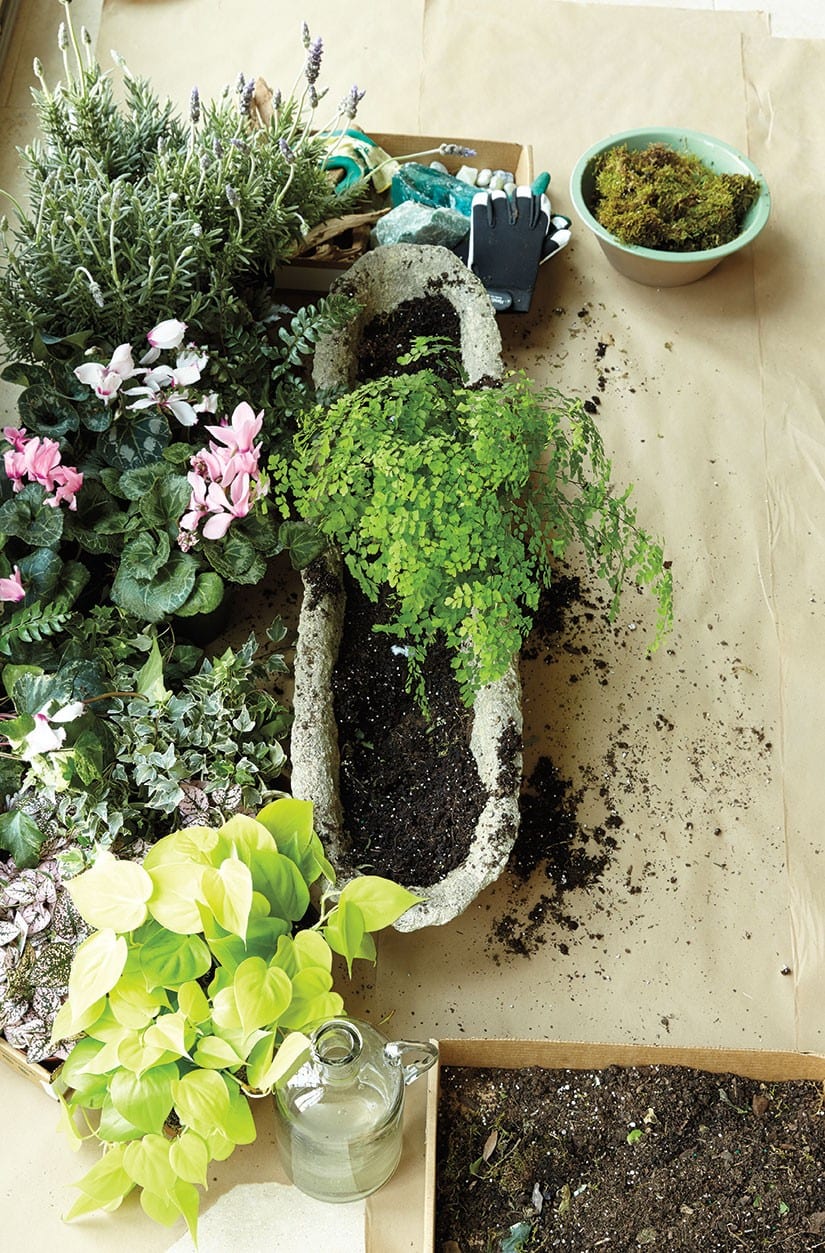One of the easiest (and most affordable) ways to make a home feel more lived-in and loved is with plants. Even if you don’t exactly have a green thumb, you can create a living arrangement for instant decor anywhere in your home. Or so says author and style editor, Eddie Ross. Watch the video above to learn how, or read the step-by-step instructions below:
Inspired by our Volcanic Ash Trough, Eddie created a living arrangement that will last through summer and into the fall. “The thing I love about a living arrangement is that you can take it from indoors to outdoors, from room to room,” he says.

Step 1: Prep Your Planter
Start with a planter that has drainage holes. We drilled three holes into the bottom of ours. Next, get good potting soil and gather the plants you want to use to create your living arrangement. The key to a beautiful arrangement is variety, says Eddie. Look for plants that offer a mix of height, color and texture. And since they’re being potted in one container, make sure your plants have similar sun and water requirements. Choose plants that appeal to you and do make sure they look healthy before bringing them home.
Eddie’s container includes:
- Begonia
- Cyclamen
- English ivy
- Lavender
- Maidenhair fern
- Philodendron
- Variegated ivy
- Sheet moss
Now that you’re ready, add three inches of potting soil to your container. Go ahead and soak your sheet moss in water to use later on.

Step 2: Create Height
Add your largest plants first to establish the final height you want. Eddie started in the center with the maidenhair fern, then added a lavender plant on each side. “You really want to keep your larger plants symmetrical,” adds Eddie. As you free plants from their containers, gently loosen the roots with your hands before nesting them in the soil.

Step 3: Fill in with Color
No container is complete without a punch of color from flowers. Eddie chose a begonia and a couple of cyclamen plants in varying pink hues, planting them on both sides of the trough. As in decorating, remember the rule of threes: odd numbers look best when planting flowers.

Step 4: Layer in Texture
Here’s where you want to add in billowy plants that surround and weave through the larger plants for textural contrast. Eddie used a couple of different ivys. Breaking up one pot of variegated ivy to create four smaller plants, he placed two on each side. Next, he planted two of the larger, darker English ivy on either side, which also serve as additional “spiller” plants.
Step 5: Anchor with a Vibrant Spiller
By now, you should have just enough room to shoehorn in a couple of spillers on the ends. Eddie planted two philodendron in a vibrant chartreuse as a colorful counterpoint to the greenery. As it grows, it will sprawl over the sides of the planter, softening the edges and grounding the container. Sweet potato vine would also work well here.

Step 6: Add the Finishing Touches
Gently squeeze out excess water from the sheet moss and tuck in pieces between the plants. As an added bonus, the moss will help keep moisture in. Next, get creative and nestle in natural objects you may already have on hand, such as driftwood, colored glass chunks or polished stone. “These little details make an ordinary arrangement feel really special,” says the stylist. “It’s like jewelry for your plants.”
Step 7: Maintain It
“This is the arrangement you plant in the spring, and it will pretty much last you all the way into fall with proper care,” promises Eddie. The key words, though, are the last two. Be sure to water your arrangement regularly. Eddie recommends using a mister on the ferns during the week. And if your spillers become too long, simply trim them with a pair of scissors. Should any of your plants come to an untimely end, simply replace them with a new plant.
Find more decorating and entertaining ideas from Eddie Ross, watch How-To videos creating a living arrangement and edible centerpiece, or browse the products he used in his spaces.
Did you like this post and find it helpful? Rate it below and share your thoughts in the comments.







Carolyn Pierce-Dyer
For this shape, I’d suggest a vintage porcelain china fish platter. If you were to use a more oval container, a simple vintage ironstone platter would do the job beautifully. I hope this was helpful.
Anne
If you put drainage holes in the bottom, you would need to sit it inside something else for inside use.What would you suggest using for this very long container?